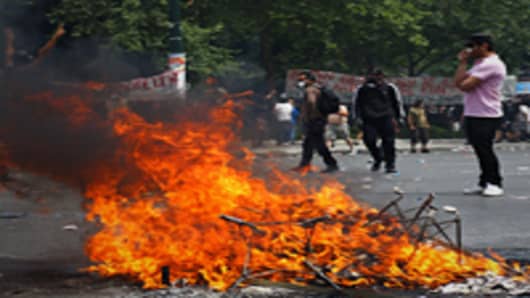Greece’s parliament square, Syntagma square, has been the center stage for protests against the country’s harsh austerity measures since spring 2010, when the first EU/IMF bailout package was signed.
Thirteen months later, on the eve of the vote of confidence for the ruling socialist party, PASOK, the masses continue to gather, but the people’s spirit has hit rock bottom. Hope for a better future after austerity measures has turned into desperation and anger, for some even into resignation. And for many it is back to square one—in this case Syntagma square.
It is a square that people in Athens flock to for shopping in fancy boutiques, or listen to street musicians during balmy summer nights, where foreigners stay in glitzy hotels.
It has now been transformed into a place where protesters of all ages and professions rally in their thousands against the harsh - and they say unjust - austerity measures imposed by the government. Speeches are being made, people are chanting, insulting the politicians and lift and banners with slogans like “Thieves, Thieves” and "Resistance is the only way".
It is a crowd which represents a people that has lost patience with the government and its relentless drive for austerity. Papandreou's administration is under immense pressure by EU and IMF to cut its ballooning deficit. Since early 2010, public sector wages were cut by a fifth and pensions by a tenth.
The latest labor market data reveal the extreme extent of the stress that is caused by austerity: In the first quarter of 2011, unemployment rate hit 15.9 percent—the highest print since quarterly records began in 1998. Greek youth unemployment has hit a staggering 30 percent in the same quarter.
But who are these protesters? The violent, anarchic and far right extremists do not usually convene on the square. The far left protestors often occupy the middle of the square, while the nationalists are found closer towards the parliament. The majority of protesters are peaceful and include businessmen, students, housewives and academics.
With patience running thin, these Greeks are infuriated and blame the country’s politicians for the dire situation they find themselves in. Some direct their anger towards authorities they suspect of being corrupt, whether that be in politics or in business.
A core group of protesters, founded on Facebook, called “The Indignants” has camped outside the parliament for 27 days in a row. A group of 30 indignant protesters began walking the 250km (155 miles) from Sparta to Athens on Sunday to join the protests today.
Critics say the protests are merely an infantile response to the real political crisis, and claim that the protestors have no objective, no clear strategy and offer no practical solution to the problems that Greece is facing.
A core protest movement called “Real Democracy”—a conservative opposition—believes that a political party may emerge from the protests on Syntagma square. However, the group remains disorganized and has no clear leader.
For now, all protesters can do is continue chanting, it seems there is little they can do but swallow the bitter pill of more austerity. At least, however, many will leave the square knowing they fought till the end.



